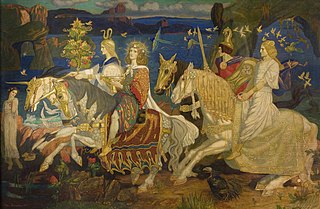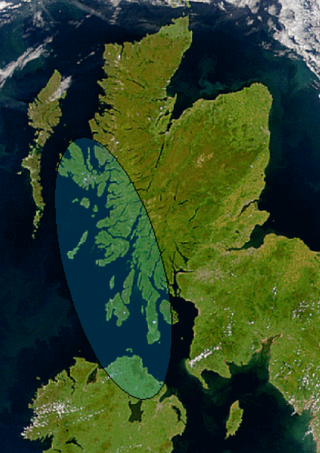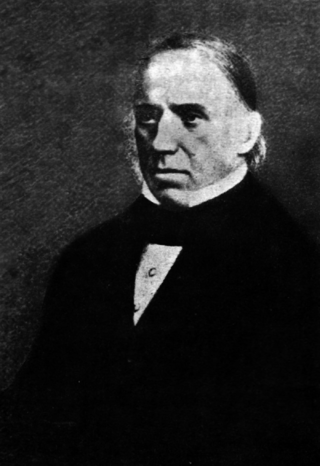
Irish mythology is the body of myths indigenous to the island of Ireland. It was originally passed down orally in the prehistoric era. In the early medieval era, some myths were transcribed by Christian monks, who heavily altered and Christianised the myths. Irish mythology is the best-preserved branch of Celtic mythology.

The TuathaDé Danann, also known by the earlier name Tuath Dé, are a supernatural race in Irish mythology. Many of them are thought to represent deities of pre-Christian Gaelic Ireland.
Conall Cernach is a hero of the Ulaid in the Ulster Cycle of Irish mythology. He had a crooked neck and is said to have always slept with the head of a Connachtman under his knee. His epithet is normally translated as "victorious" or "triumphant", although it is an obscure word, and some texts struggle to explain it. Alternative meanings include "angular, having corners", "swollen", or "possessing a dish or receptacle". The original form of the name "Conall" in Ogham inscriptions was Cunavalas.

Áedán mac Gabráin, also written as Aedan, was a king of Dál Riata from c. 574 until c. 609 AD. The kingdom of Dál Riata was situated in modern Argyll and Bute, Scotland, and parts of County Antrim, Ireland. Genealogies record that Áedán was a son of Gabrán mac Domangairt.

Lebor Gabála Érenn is a collection of poems and prose narratives in the Irish language intended to be a history of Ireland and the Irish from the creation of the world to the Middle Ages. There are a number of versions, the earliest of which was compiled by an anonymous writer in the 11th century. It synthesised narratives that had been developing over the foregoing centuries. The Lebor Gabála tells of Ireland being settled six times by six groups of people: the people of Cessair, the people of Partholón, the people of Nemed, the Fir Bolg, the Tuatha Dé Danann, and the Milesians. The first four groups are wiped out or forced to abandon the island; the fifth group represents Ireland's pagan gods, while the final group represents the Irish people.

Early Irish law, also called Brehon law, comprised the statutes which governed everyday life in Early Medieval Ireland. They were partially eclipsed by the Norman invasion of 1169, but underwent a resurgence from the 13th until the 17th century, over the majority of the island, and survived into Early Modern Ireland in parallel with English law. Early Irish law was often mixed with Christian influence and juristic innovation. These secular laws existed in parallel, and occasionally in conflict, with canon law throughout the early Christian period.

Cath Maige Tuired is the name of two saga texts of the Mythological Cycle of Irish mythology. It refers to two separate battles in Connacht: the first in the territory of Conmhaícne Cúile Tuireadh near Cong, County Mayo, the second near Lough Arrow in County Sligo. The two texts tell of battles fought by the Tuatha Dé Danann, the first against the Fir Bolg, and the second against the Fomorians.
Lebor na hUidre or the Book of the Dun Cow is an Irish vellum manuscript dating to the 12th century. It is the oldest extant manuscript in Irish. It is held in the Royal Irish Academy and is badly damaged: only 67 leaves remain and many of the texts are incomplete. It is named after an anachronistic legend that it was made from the hide of a dun cow by Saint Ciarán of Clonmacnoise.

Eugene O'Curry was an Irish philologist and antiquary.
Lóegaire (died c. 462), also Lóeguire, is said to have been a son of Niall of the Nine Hostages. The Irish annals and king lists include him as a King of Tara or High King of Ireland. He appears as an adversary of Saint Patrick in several hagiographies. His dealings with the saint were believed to account for his descendants' lack of importance in later times. There are several accounts of his death, all of which contain supernatural elements, some of which concern his wars against Leinster.
Gilbert Hay or Sir Gilbert the Haye, Scottish poet and translator, was perhaps a kinsman of the house of Errol.
Brehon is a term for a historical arbitration, mediative and judicial role in Gaelic culture. Brehons were part of the system of Early Irish law, which was also simply called "Brehon law". Brehons were judges, close in importance to the chiefs.
In the Ulster Cycle of early Irish literature, the Lúin of Celtchar is the name of a long, fiery lance or spear belonging to Celtchar mac Uthechar and wielded by other heroes, such as Dubthach, Mac Cécht and Fedlimid.
The Pictish Chronicle is a name used to refer to a pseudo-historical account of the kings of the Picts beginning many thousand years before history was recorded in Pictavia and ending after Pictavia had been enveloped by Scotland.
Llefelys is a character in Welsh mythology appearing in the medieval Welsh tale Cyfranc Lludd a Llefelys. In the tale, Llefelys is king of Gaul while his brother Lludd is king of Britain. The tale appears in the Red Book of Hergest and the White Book of Rhydderch, the source texts for the Mabinogion, and embedded into various versions of the Brut y Brenhinedd, the Welsh adaptation of Geoffrey of Monmouth's Historia Regum Britanniae.
Lommán mac Dalláin was a saint and patron of Trim, County Meath in Ireland.
Fled Bricrenn is a story from the Ulster Cycle of Irish mythology. Bricriu, an inveterate troublemaker, invites the nobles of the Ulaid to a feast at his new bruiden at Dún Rudraige, where he incites three heroes, Cúchulainn, Conall Cernach, and Lóegaire Búadach, to compete for the "champion's portion" of the feast. The three heroes perform several feats, and travel to Connacht to be judged by Ailill and Medb, and to Munster to be judged by Cú Roí; on each occasion, Cúchulainn is proclaimed champion, but the other two refuse to accept. Eventually, back at Emain Macha, the three heroes are each challenged by a giant churl to cut off his head, on the condition that they allow him to cut off their heads in return. First Lóegaire, then Conall, takes up the challenge and cuts off the churl's head, only for him to pick it up and leave, but when the churl returns the following night they are nowhere to be seen. Only Cúchulainn lives up to his side of the bargain. The churl spares his life, reveals himself to be Cú Roí in disguise, and announces that Cúchulainn's bravery and honour make him an undisputed champion.
John Carey is an American philologist, professor, and scholar of Celtic studies, specialising in subjects of early Irish and Welsh literature, religion, and mythology. A graduate of Harvard University, he was an associate professor at the Department of Celtic Languages and Literature. He has received fellowships at Warburg Institute, the Institute of Irish Studies at Queen's University, Belfast and the Dublin Institute for Advanced Studies. He later moved to the Department of Early and Medieval Irish at the University College Cork (UCC), where he now teaches. He is fellow at the Temenos Academy and editor of Temenos Academy Review.
Dubthach maccu Lugair, is a legendary Irish poet and lawyer who supposedly lived at the time of St Patrick's mission in Ireland and in the reign of Lóegaire mac Néill, high-king of Ireland, to which Dubthach served as Chief Poet and Brehon. In contrast to the king and his druids, he is said to have readily accepted the new religion. This event has played a major part in Hiberno-Latin and Irish sources as representing the integration of native Irish learning with the Christian faith.

The Proverbia Grecorum is an anonymous Latin collection of proverbs compiled in the seventh or eighth century AD in the British Isles, probably in Ireland. Despite the name, it has no known Greek source. It was perhaps designed as a secular complement to the Hebrew Bible's Book of Proverbs.







